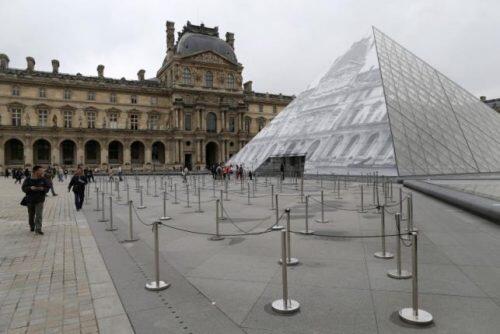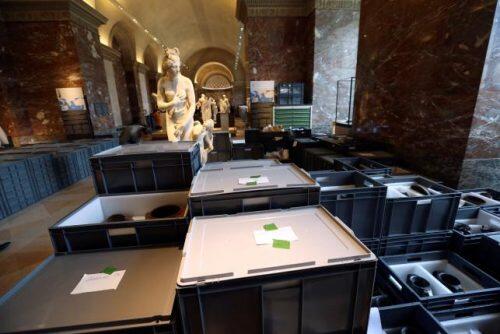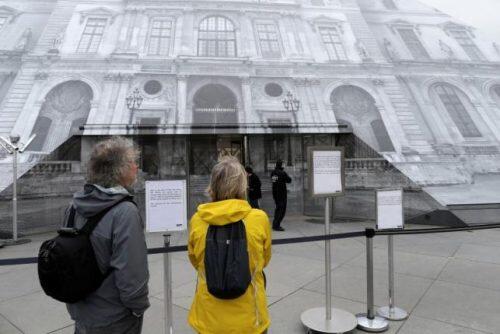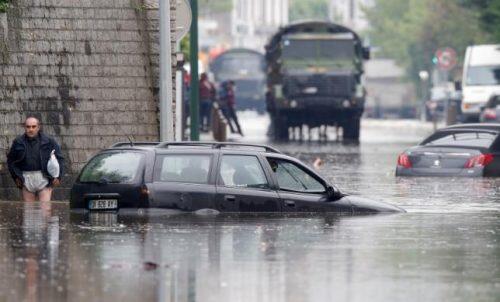The Louvre and Orsay museums in Paris moved scores of artworks and precious artifacts to safety and soldiers evacuated residents trapped in some of the French capital’s suburbs as the rain-swollen river Seine hit its highest level in 30 years.
Tourists walk past empty waiting lines as the Louvre Museum is closed due to the rising Seine River in Paris, France, after days of almost non-stop rain caused flooding in the country, June 3, 2016. REUTERS/John Schults
Environment Minister Segolene Royal said the Seine had breached 6 meters (19 feet) in central Paris, submerging riverside roads, swamping small businesses on quaysides and forcing the closure of an underground commuter line.
The worst affected areas lay just to the south of the capital. In Villeneuve-Saint-Georges near Orly airport, soldiers and Red Cross volunteers helped stranded residents as flood waters rose above knee level. In nearby Corbeil-Essonnes, locals kayaked along streets littered with abandoned cars.
Crates containing pieces of artworks from the collections of the Louvre Museum are seen near statues after the museum was closed to the public due to the rising Seine River in Paris, France, after days of almost non-stop rain caused flooding in the country, June 3, 2016. REUTERS/John Schults
“It’s a bit frightening, everything that’s happening,” said one woman from Marseille who identified herself only as Odile. “Not long ago they ran a flood simulation, how to evacuate museums, residents. And now it’s happening for real.”
Tourists read information notices that indicate that the Louvre Museum is closed due to the rising Seine River in Paris, France, after days of almost non-stop rain caused flooding in the country, June 3, 2016. REUTERS/John Schults
The heavy flooding of the past week could cost French insurance companies some 600 million euros ($680.5 million) or more, industry association AFA said.
Both the Louvre and Orsay museums overlooking the Seine were closed to the public on Friday. In the Louvre, workers stacked dozens of boxes marked fragile and containing valuable statues, vases and artworks. Crates could be seen stacked in corridors, overlooked by classical marble statues.
A resident walks past abandoned cars as he escapes from the flooded area of Villeneuve-Trillage suburb in Villeneuve Saint-Georges, outside Paris, June 3, 2016 after days of almost non-stop rain caused flooding in the country. REUTERS/Christian Hartmann
“For the museums, even if fortunately there isn’t any flooding of storerooms as of today, there is an automatic process above 5.50 meters to move works in the deepest storerooms higher,” Bruno Julliard, Paris’ deputy mayor, told France Inter radio.
The Louvre and the Musee d’Orsay are both home to world-renowned art collections, the former including the celebrated Mona Lisa painting and Venus de Milo statue.
Even as the Seine crested higher, it remained well below the record high of 8.6 meters reached in 1910, when thousands of Parisians had to flee inundated low-lying areas of the city.
Officials said the river could peak at 6.50 meters later on Friday, and warned flood waters could take several weeks to recede after the wettest May in France for 100 years.
“What’s going to be even more painful for the families who have lost their homes, the heads of companies who have lost their businesses, employees who will be unable to go to work, is that the drop in the water level will be very slow,” Royal said.
The retreating waters could reveal further victims, she added.
Barges are moored together near the Eiffel Tower as high waters cover the banks of the Seine River in Paris, France, after days of almost non-stop rain caused flooding in the country, June 2, 2016. REUTERS/Jacky Naegelen
In Evry-Gregy-sur-Yerre, a man on horseback drowned on Thursday, becoming the first fatality from the flooding caused by days of unusually torrential rain.
A women was found dead on Friday after having drowned in a river located in the Loiret department, central France, the local prefecture told BFM television.
Prime minister Manuel Valls told journalists the death of a woman on Wednesday was not linked to the flooding, as earlier thought.
Source: REUTERS
















